Technically not a plum, but definitely a pine!
Names
Australia, like much of the former southern continent of Gondwana, was and remains a home to a vast array of interesting species of flora. The Podocarpus (P.) family of conifers are one of those ancient plants with some 100 named species globally, of which seven species call Australia home.
The most common of these are the east-coast’s plum pine or Illawarra plum (Podocarpus elatus); the tropical brown pine (P. grayae); the dwarf plum pine or spiny plum pine (P. spinulosus); the west-Australian bush plum (P. drouynianus); the broad-leaved plum pine (P. dispermus); Smith’s brown pine (P. smithii); and the mountain, alpine or Errinundra plum (P. lawrencei).
As a necessary note for my international readers, Podocarpus has an extensive natural range into most of the southern hemisphere, especially South America and southern Africa. The genus is also present in significant portions of southern and eastern Asia in the northern hemisphere, such as eastern and southern India, Thailand, Malaysia, China and Japan. Species of interest to foragers in those other parts of the world include Buddha’s pine or kusamaki (P. macrophyllus); the national tree of South Africa, the yellowwood (P. latifolius); the Malay jati bukit (P. polystachyus); and South America has several prominent species extending as far south as the 38’ parallel, including Mañío de hojas largas (P. salignus) and male maniu or mañío de hojas punzantes (P. nubigenus). Some of these species, most notably P. macrophyllus and P. nubigenus, have been introduced into Britain, Europe and North America as ornamentals.
New Zealand has several significant Podocarpus species: the needle-leaved tōtara (P. acutifolius); the alpine tōtara (P. nivalis); and the common tōtara (P. totara) will be encountered throughout that country (Paitu, 2024). Additionally, the very closely related kahikatea or white pine (Dacrycarpus dacrydioides) and the similarly edible miro (Prumnopitys ferruginea) and matai (Prumnopitys taxifolia) round out similar-looking plants worthy of foraging attention for my neighbours across the ditch. I will not comment too much more in this article about the international species, but trust that those with an interest may follow them up at their leisure.
Habitat and Range
In Australia, plum pines are primarily rainforest trees, tropical and temperate, being lovers of the rich, organic material and abundant water to be found in rainforest and riverine ecosystems, where the trees may grow freely to their maximum proportions, often exceeding 30 metres (90 ft.) in height. Many Podocarpus species are salt-resistant, so they can also grow easily in forests literally adjacent to the saline coast or mangrove saltmarshes, although excessively saline environments will typically stunt their growth to less than 5 metres. Tropical understory plum pines typically also remain in a shrubby state due to a lack of light, at least until they get a rare break in the canopy and a chance to grow. The majority of Australian species are frost intolerant (excepting, of course, the alpine variety P. lawrencei), thus they will not be found nor happy in many areas experiencing regular winter frosts.
The most common species on the eastern coast are the esteemed Illawarra plum (P. elatus), which ranges from Mackay in the north to Eden in the south; and the dwarf plum pine (P. spinulosus), mainly found in forests of the northern Hunter Valley south to the Illawarra region of New South Wales. One species, the Errinundra plum (P. lawrencei), is found to the alpine region of Australia’s Snowy Mountains (up to 1,800m) and throughout the snowy highlands of Tasmania and New Zealand. Three species are endemic to the tropical rainforests of North Queensland: the tropical brown pine (P. grayae) which grows throughout the eastern edge of the Cape York Peninsula; Smith’s plum pine (P. smithii) and the broad-leaved plum pine (P. dispermus) both dwell exclusively in the eastern part of the Atherton tablelands and the region surrounding Cairns. One more shrubby species dwells exclusively in Western Australia’s south-west corner (P. drouynianus).
Identification
Key Identifying Features
Often a tall, 15-30m, evergreen rainforest tree (P. elatus; P. grayae); or a shrubby, 3-8m tropical understory tree (P. spinulosus; P. dispermus; P. smithii); or a small, exposed shrub, 1-3m (P. drouynianus and P. lawrencei, although there are 15m specimens of the latter in the Errinundra region of Victoria).
Trunk bark is brown, stringy, often with long furrows and corky in texture.
Branching is somewhat eccentric, unlike most other pines which grow their branches in concentric whorls.
Leaf size/shape very much depends on the species: P. elatus, P. spinulosus, P. drouynianus and P. grayae have long, thin and spear-tip shaped (lanceolate) leaves, 5-20 cm in length but only 0.5 to 1.5cm in width; broad leaved plum pine (P. dispermus) and Smith’s plum pine (P. smithii) have the broadest leaves, often 10-15 cm in length and 1.5-3 cm in width; alpine plum (P. lawrencei) has the smallest leaves at 1 cm in length and 0.2-0.3 cm in width, often with blunt, rounded tips.
Leaves have a single, long, central vein from stem to tip (except P. lawrencei, whose leaf vein is often inconspicuous); the leaves have a deep green hue with an almost artificial or plastic appearance.
Leaves grow in “pseudowhorls,” but are otherwise alternate.
Leaves emit an aromatic, resinous “pine” scent when rubbed or crushed.
Male flowers are highly irritating, pollen-bearing catkins (rating 10/10 on the Ogren plant allergy scale [Ogren, 2000: 180ff.]).
Female cones start as a dusky, green, fleshy, berry-like fruit consisting of 1-3 completely fused scales with 1 (rarely 2 or 3) fully exposed seeds at the tip.
Female cones swell considerably while ripening, changing colour to red and then dark purple (some species, dark red) when fully ripe; the seed at the tip will be green or gray, depending on the species, often with a dusky coating.
The first distinctive feature of the vast majority of Podocarpus species is their rich brown, stringy and deeply furrowed bark, particularly in the older trees, hence their most common, unassuming name, “brown pine.” Unlike most conifers which branch in concentric whorls, Podocarpus have a fairly erratic branching habit, often making them indistinguishable from the Eucalyptus and Acacia they so frequently live alongside by their branching habits alone.
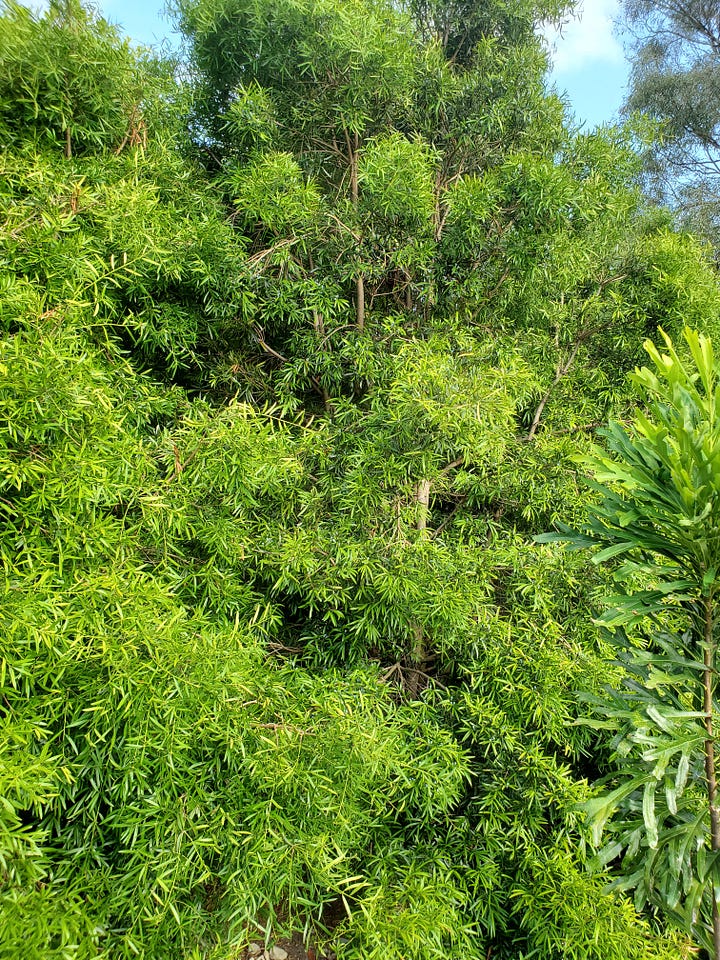
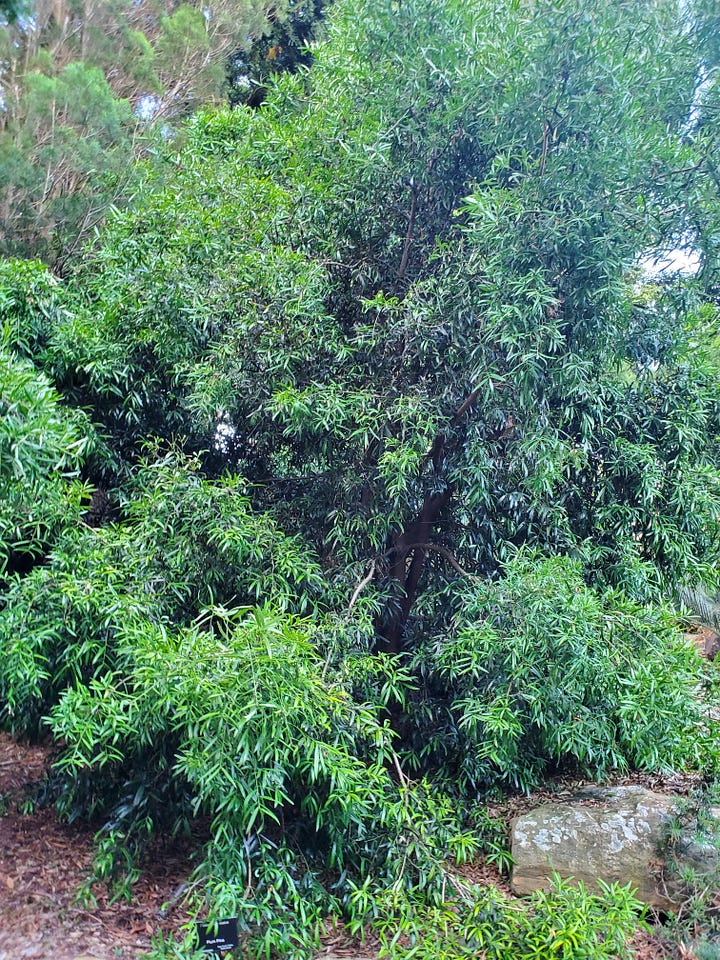

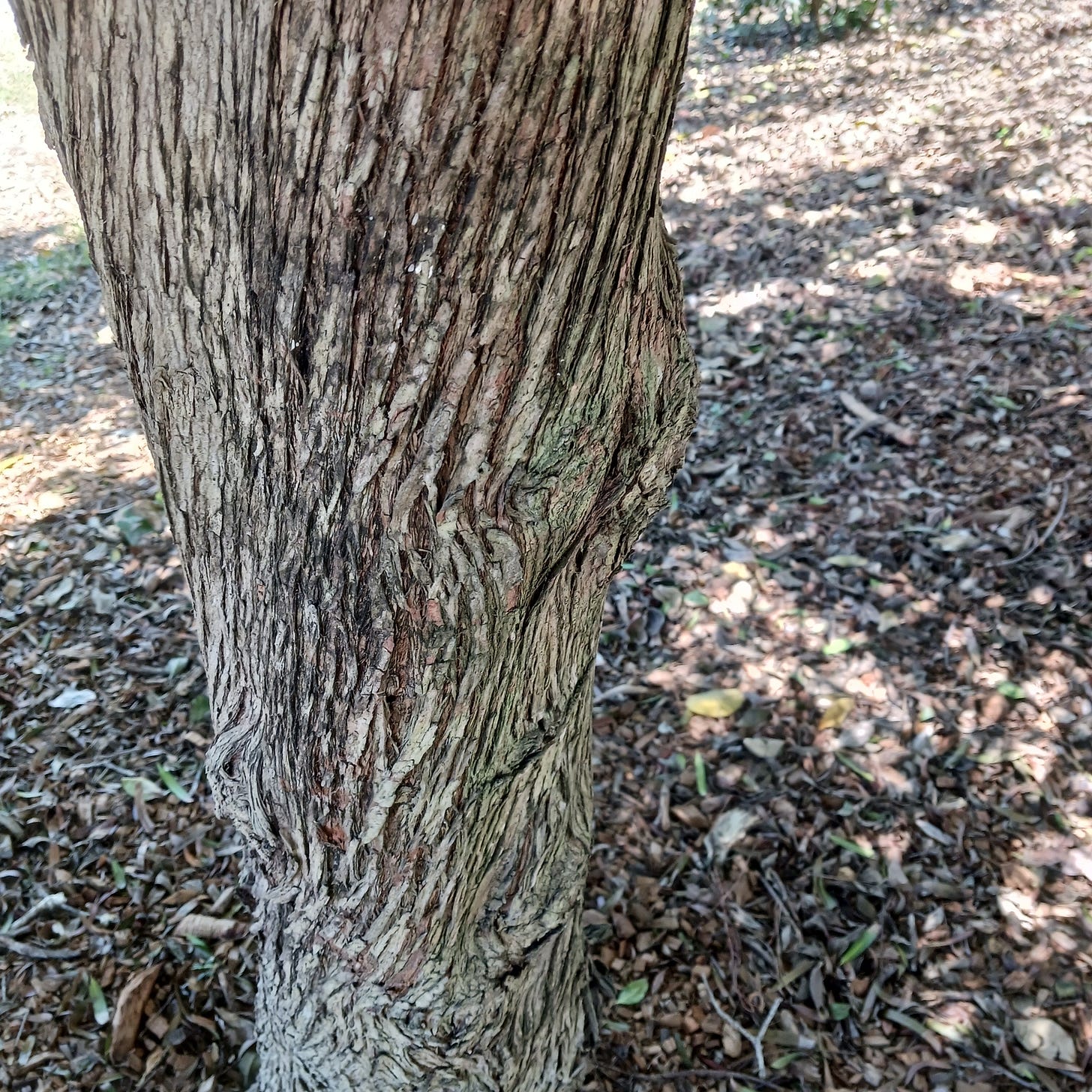
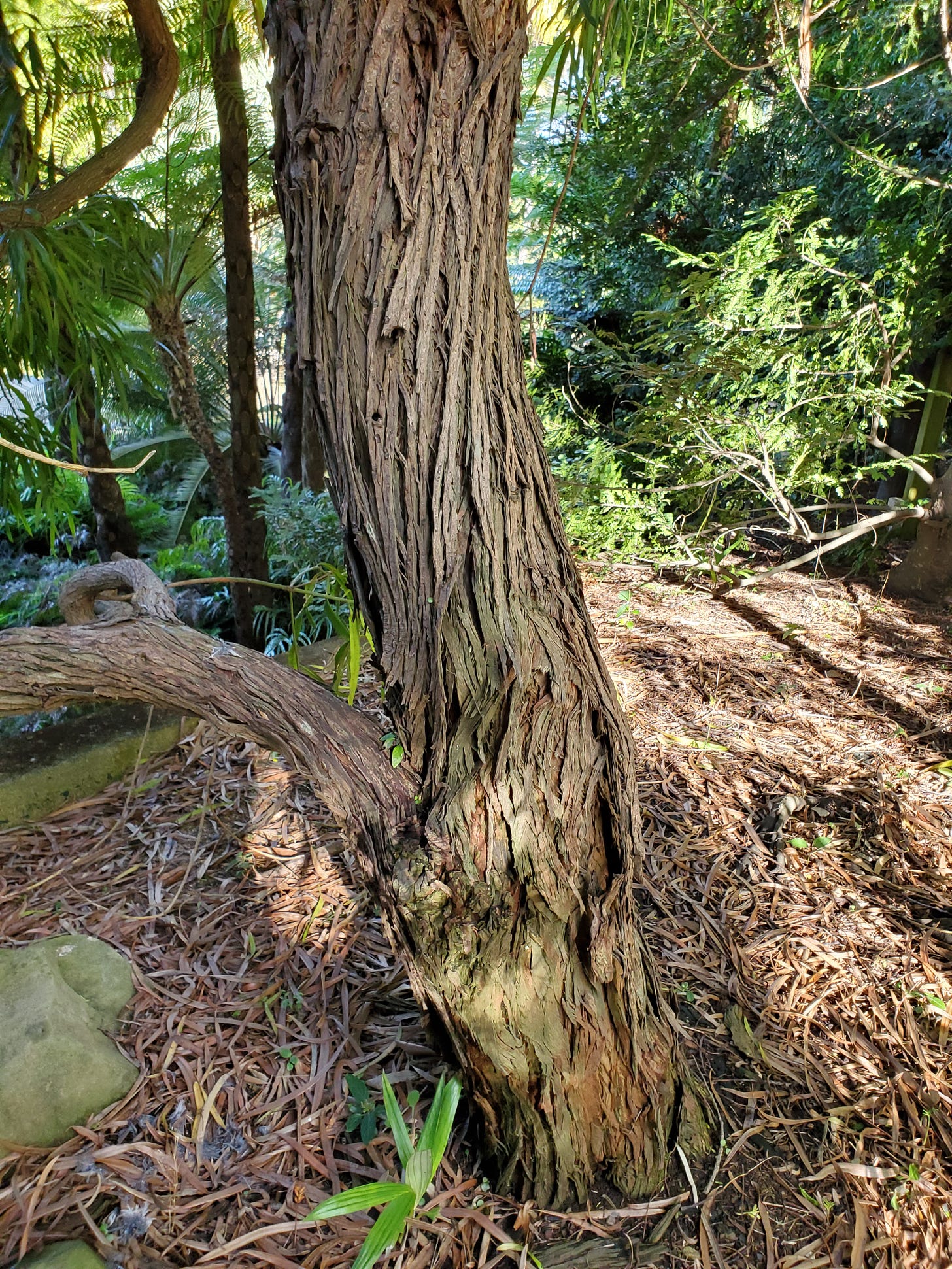


The foliage of most species is spear-tip shaped (lanceolate), long and thin, of a deep green, almost plastic, sheen. Leaves grow alternately but often in a “pseudo-whorl,” closely, but not exactly, following the predictable Fibonacci spiral (1.618) nature loves to display. Some species terminate their leaf apex with a pointed (P. elatus; P. grayae; P. dispermum; P. smithii; P. drouynianus) or spiky (P. spinulosus) tip; the alpine species is much smaller, blunter and rounded (P. lawrencei). Virtually all Podocarpus exhibit a single, central vein along the entire length of the leaf from stem to tip (inconspicuous but present on the alpine species). Terminal (end-tip) branches often exhibit the minuscule buds of next season’s growth.
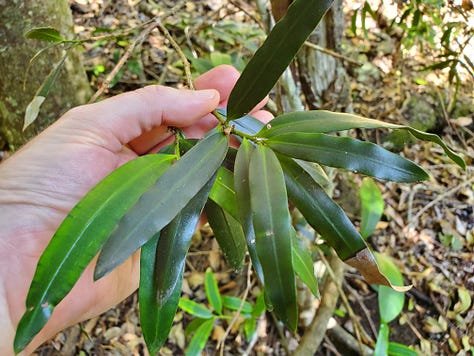



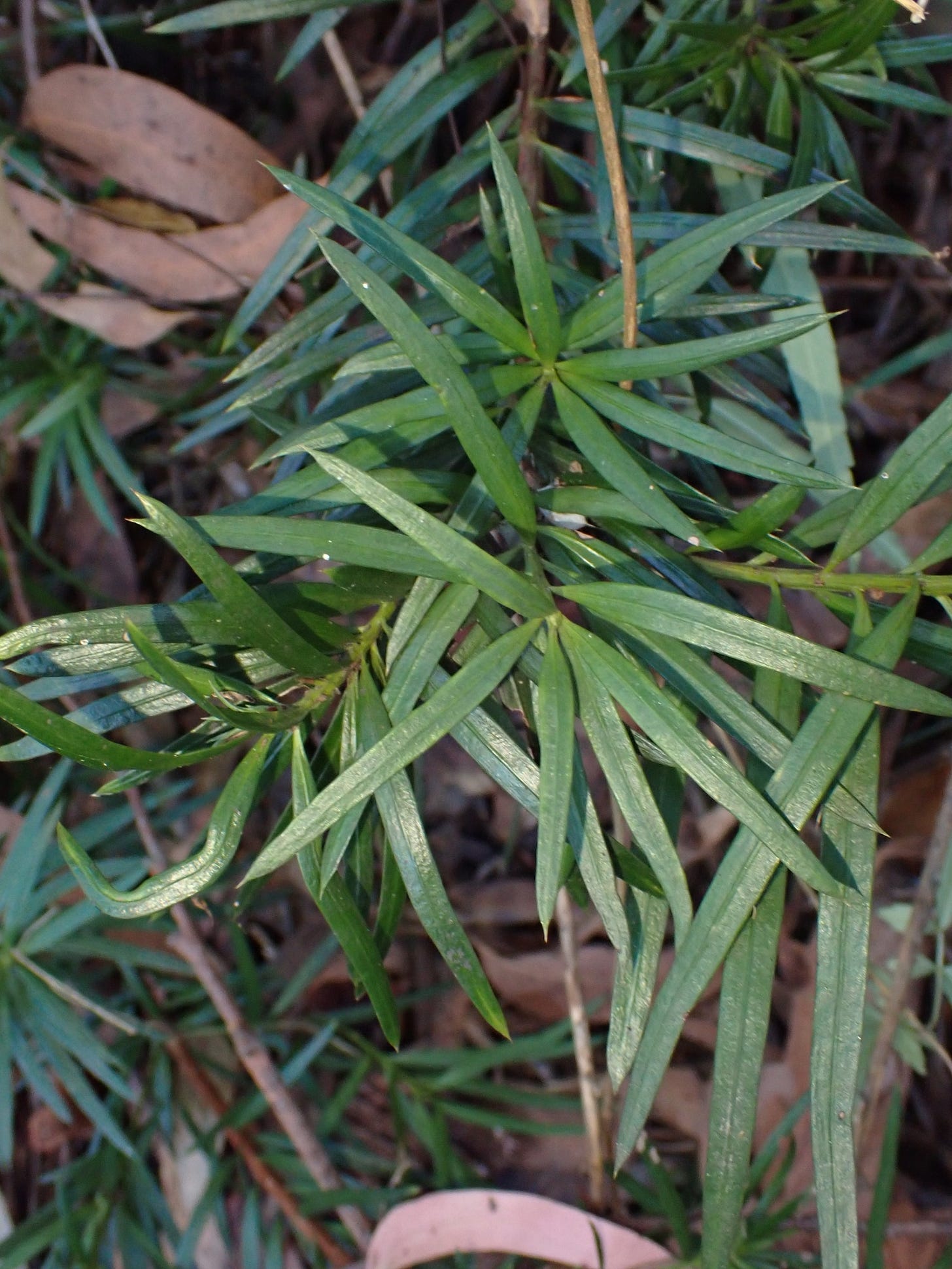
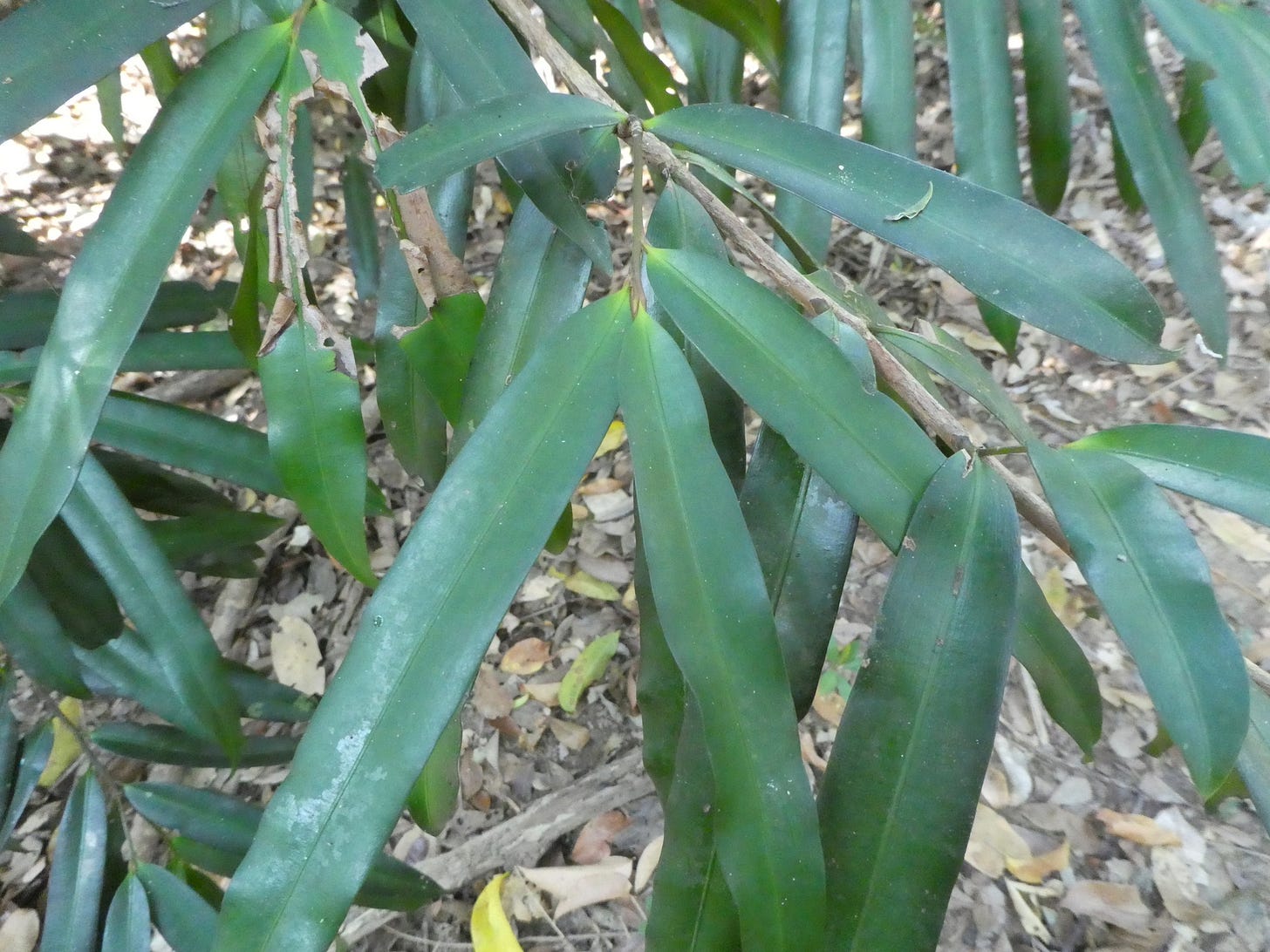
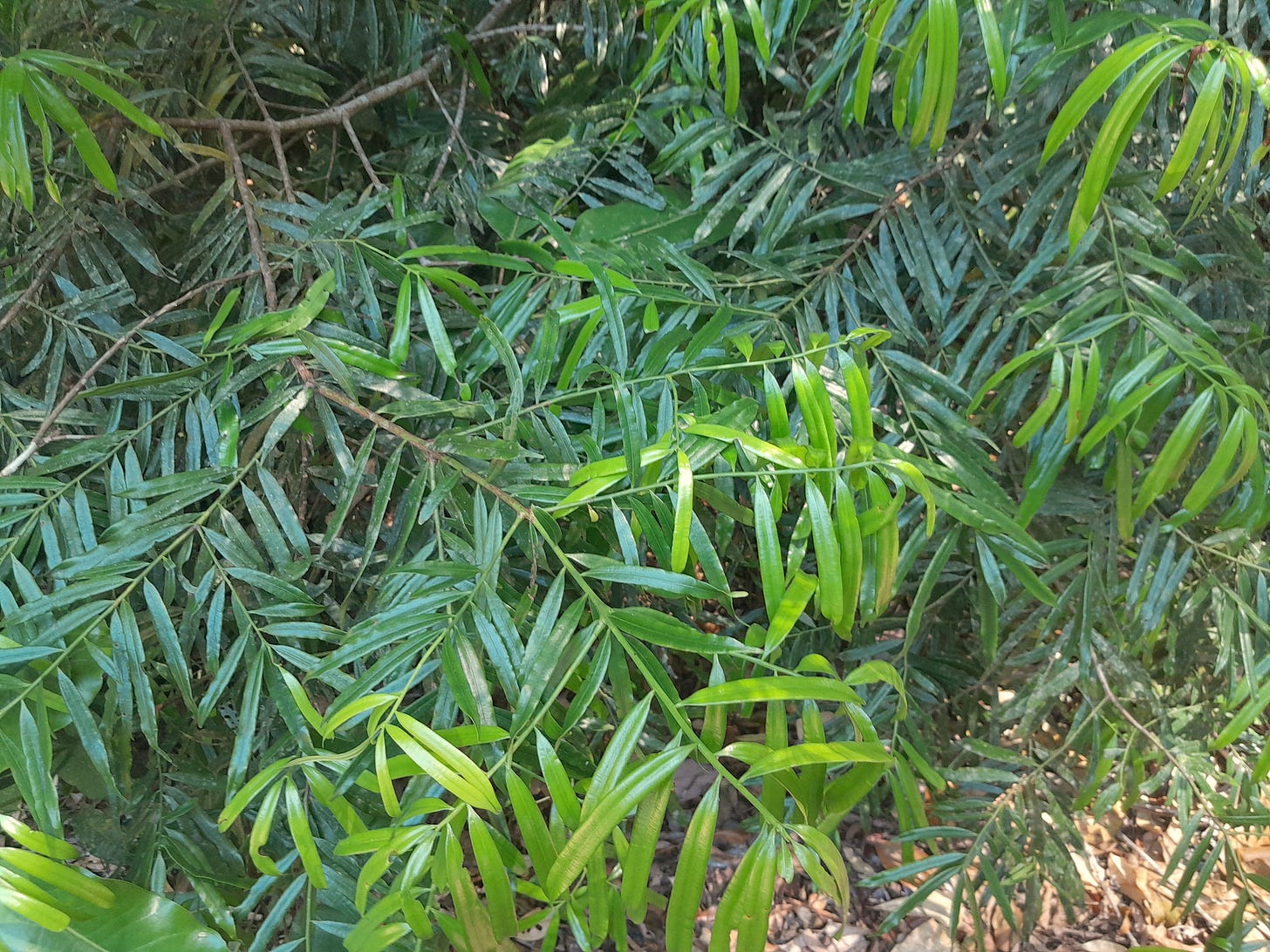
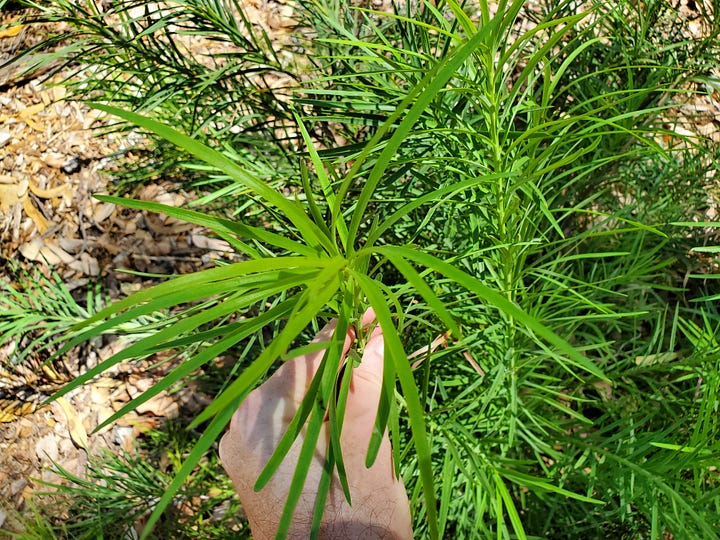
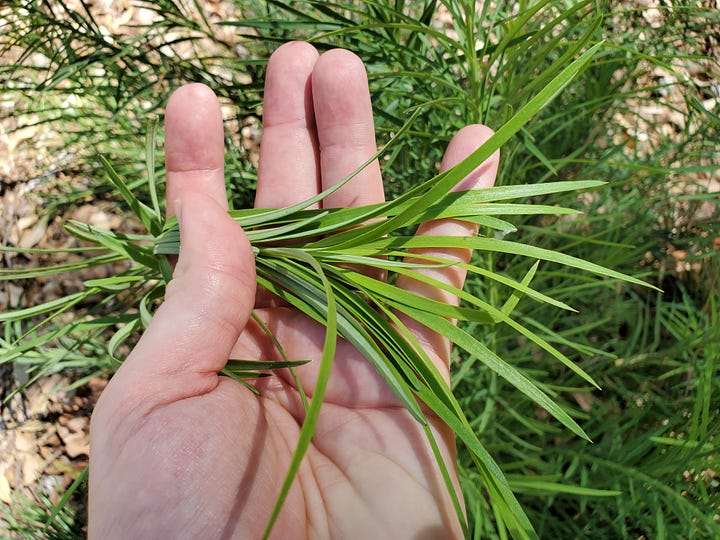

As with many other native conifers, Australian Podocarpus trees are dioecious, having distinct male and female genders on separate plants. Males exhibit pollen-bearing catkins similar to most other pines. The pollen of virtually all male species of Podocarpus is extremely irritating and possesses known cytotoxic (cell-destroying) potential (Ogren, 2000: 180ff.). Note: male plum pines will never bear any fruit, ever! However, male trees are absolutely necessary to effect pollination of the completely benign, non-irritating female cones for fruit maturity. Male catkins will be most active in the spring (August-November).

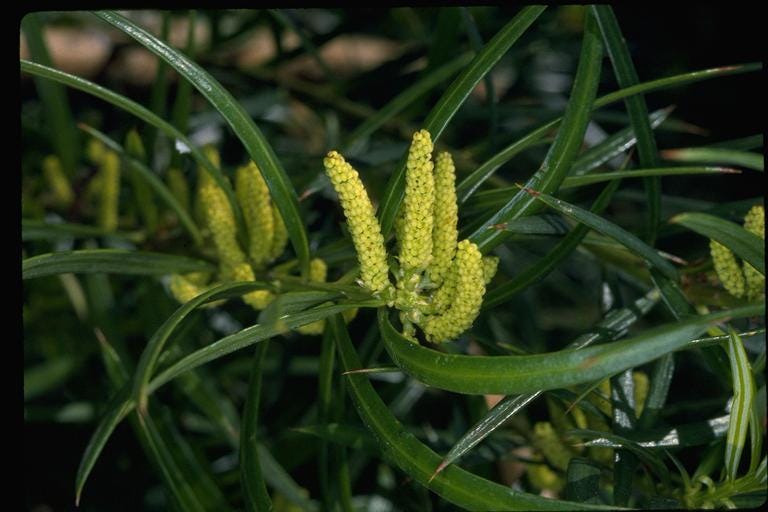
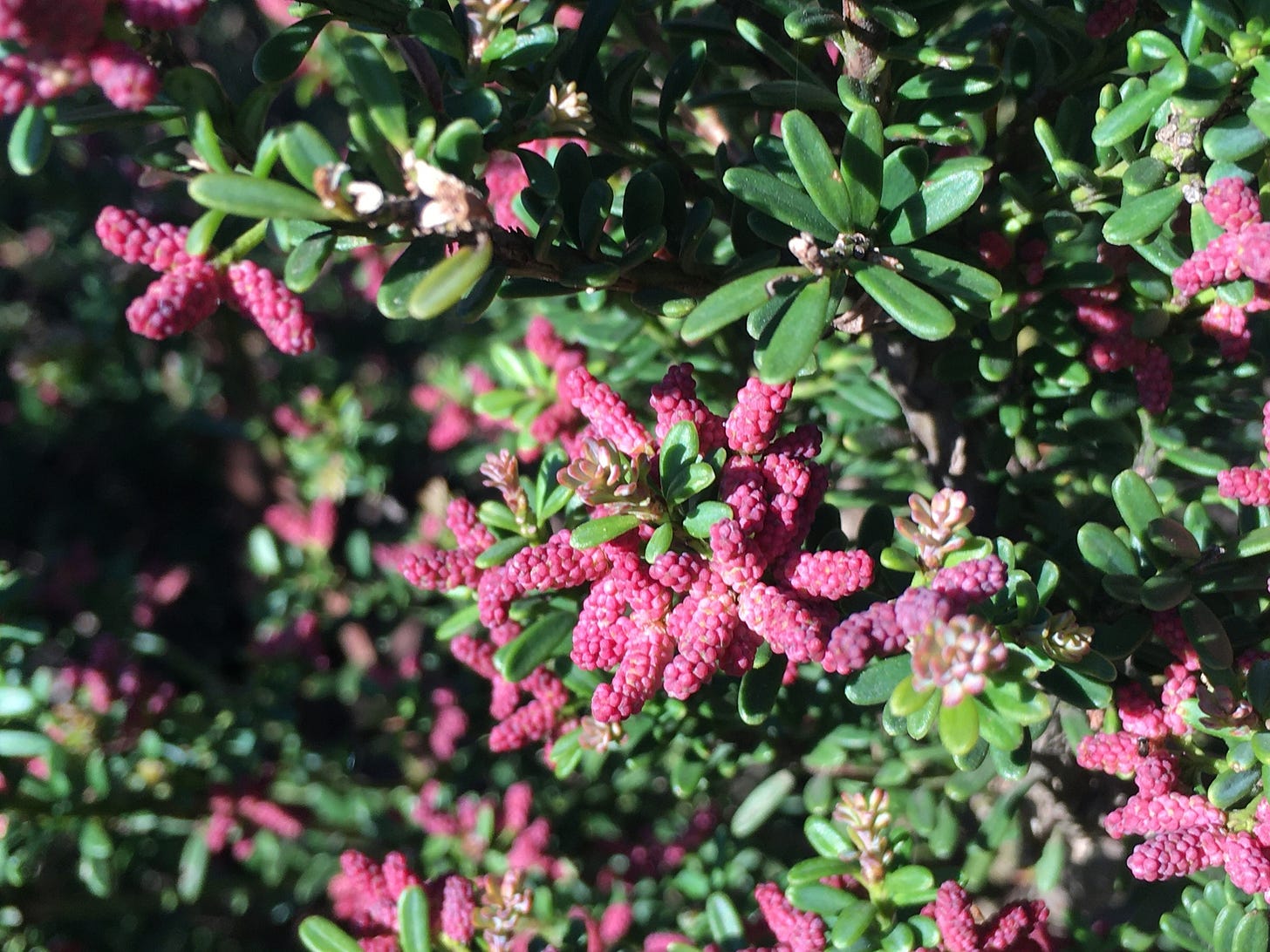
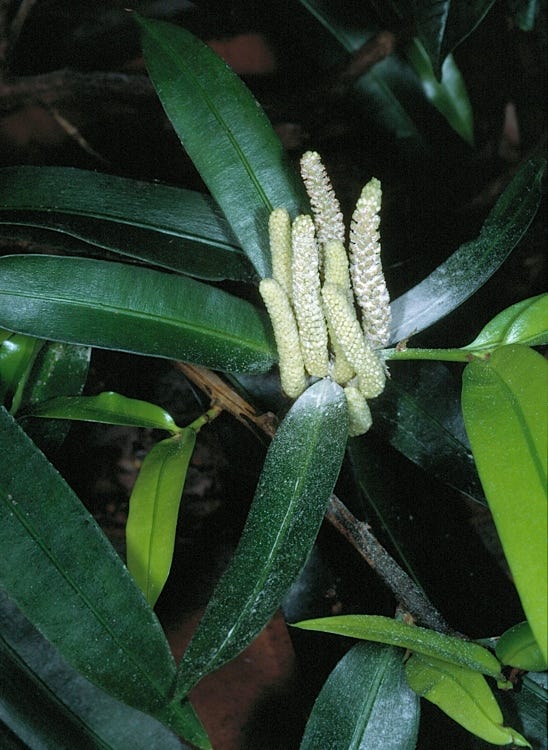

Female trees are the target of the keen-eyed bush food forager, for it is their highly modified, fused, seed-tipped cone scales which eventually swell to form the esteemed edible “plum.” The ripe fruits have a truly distinct appearance, being a single dusky gray-green seed (rarely two or three) attached at the tip of a soft, usually deep purple-black (P. elatus; P. spinulosus; P. drouynianus) or red swollen base (P. grayae; P. dispermus; P. lawrencei; probably P. smithii [no photography available] and most international species are also varying shades of red when ripe). Ripe fruit will fall off the tree into your hand when gently tugged, or scatter about on the ground beneath specimens too tall to see above the rainforest canopy. Fallen semi-dried fruit retains its edible characteristics and can be harvested just as bountifully as fresh fruit still on the tree. Fruit commences formation in November-January and ripens in late March-July.

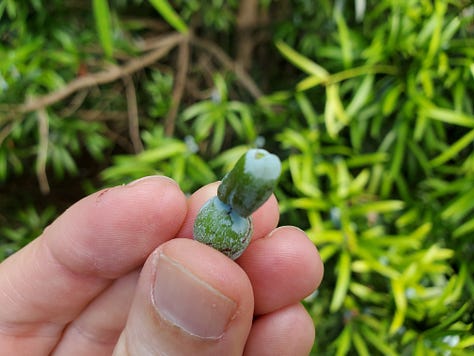
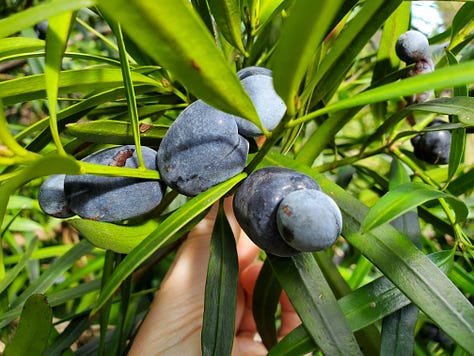
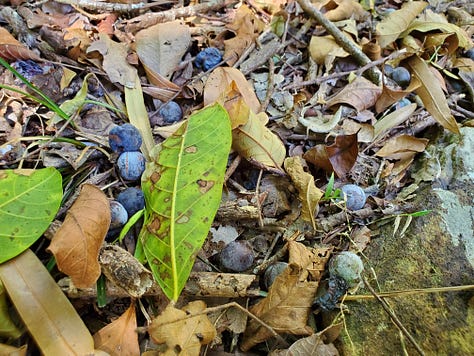

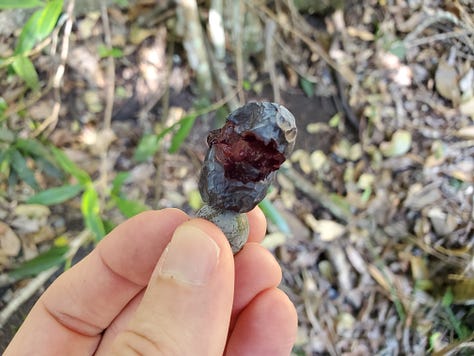
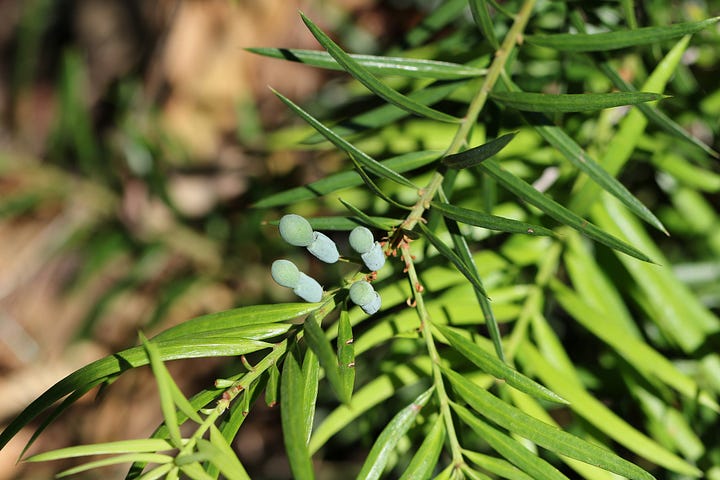

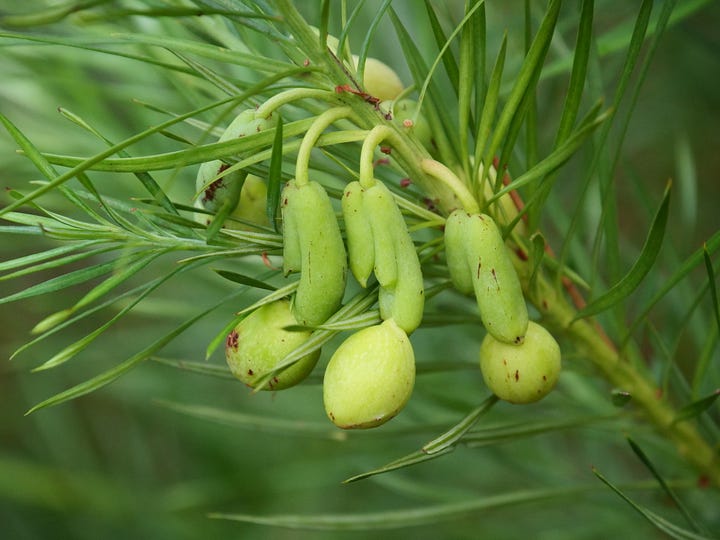
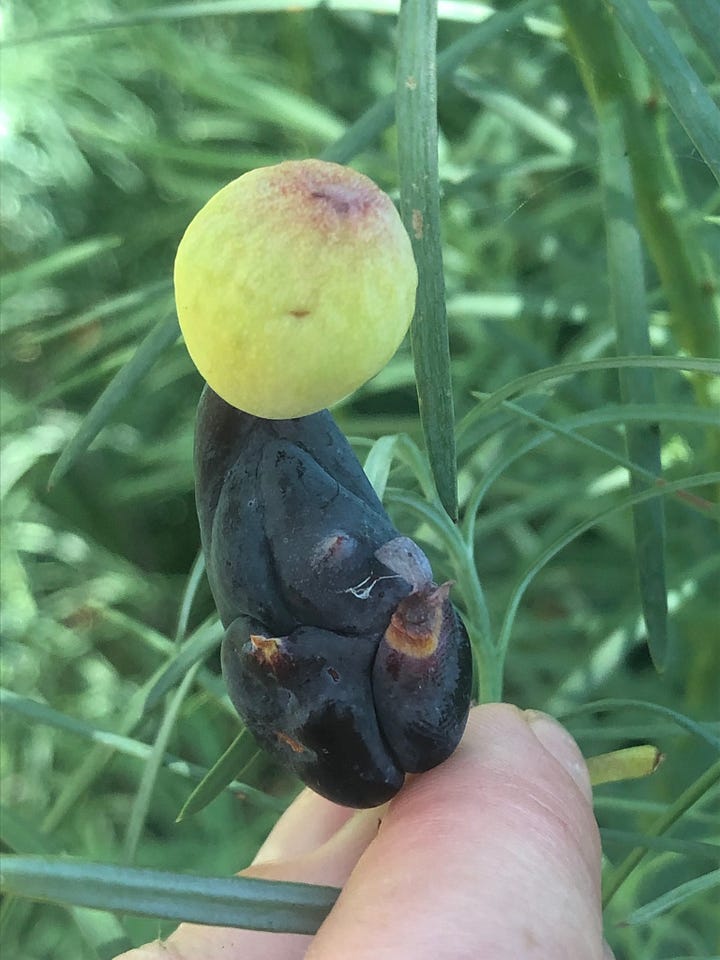
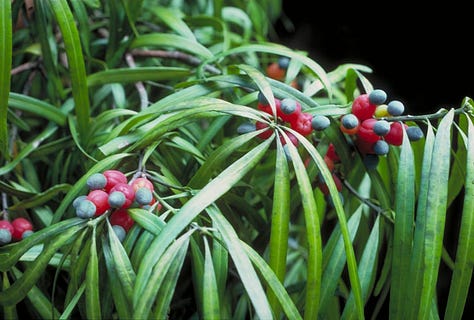
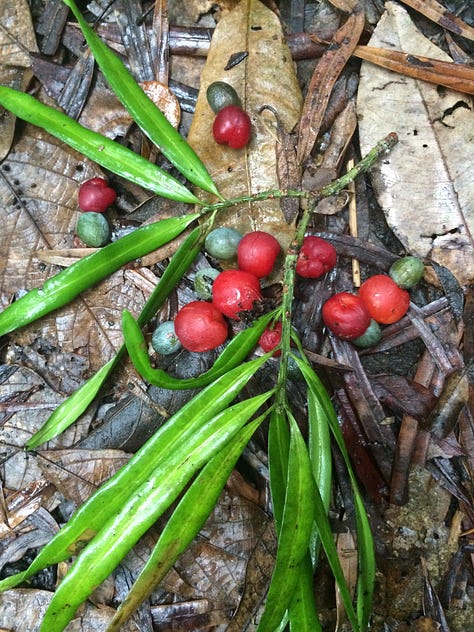
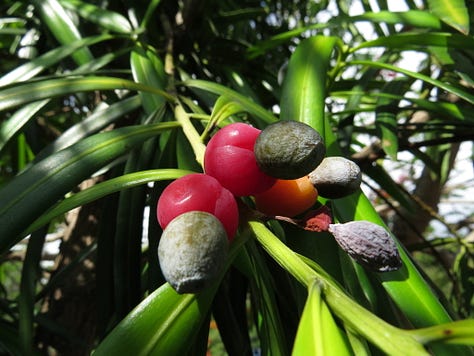


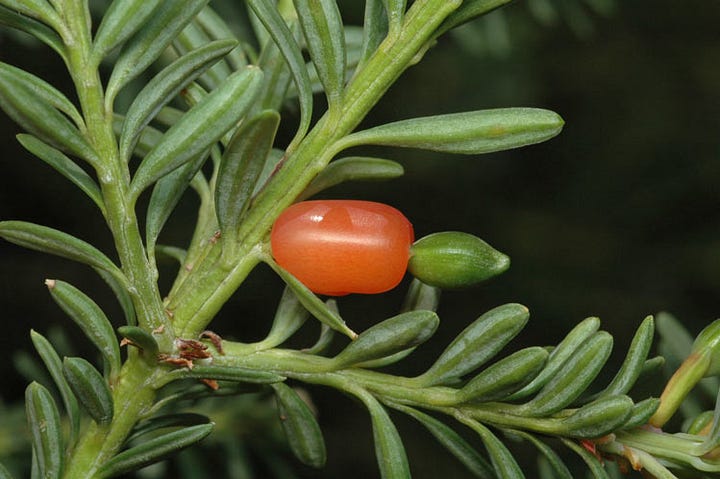
Culinary Uses
Plum pine can be enjoyed raw or cooked while the fruits are widely available in their peak season roughly from late March through to July (seasons may be earlier in the tropical north and later in the cold/alpine regions of NSW, Victoria and Tasmania). I find the flavour reminiscent of black plums but with a resinous pine, rather than sour, aftertaste. That said, it is certainly one of Australia’s better-tasting bush food items. The texture of the fruit is somewhat gelatinous and slimy but otherwise pleasant and easily devoured given that the hard, inedible seed at the tip can simply be twisted off and discarded. I repeat: do not eat the hard seed at the tip! Plant it somewhere and get more of these girls growing free food for yourself and others.
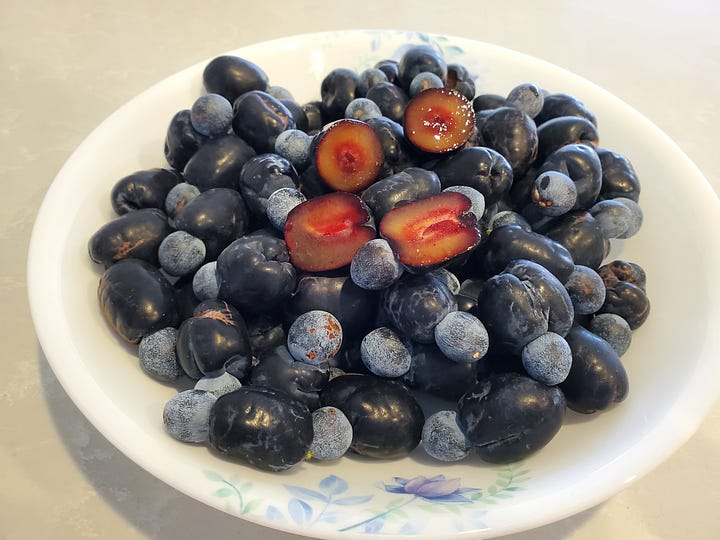

Each fruit will contain one resinous core (per seed; in the case of multi-seeded fruit, e.g. P. dispermus, there will be multiple resinous cores in the fruit) which is supposedly the most toxic part (the central reddish part in the cross-sectioned fruit in Figure 40 above). I have eaten these resinous cores in moderation without ill effect, but the cores are generally tough, chewy and have a bitter, resinous pine flavour; these parts are best discarded along with the seed. I have personally consumed 5-6 Illawarra plums per day for an entire month without noticeable ill effects, a contrary testament to the hyperchondria of the ignorant and bush-tucker ne’erdowells (I am yet to repeat the feat with the far more elusive “toxic” alpine plum, P. lawrencei).
The fruit takes well to cooking in jams, puddings, pastries and various alcoholic macerations, but care should be taken to remove all seeds and cores prior to cooking with them. One Australian gin manufacturer has replaced sloe berries (Prunus spinosa) with Illawarra plum (Podocarpus elatus) fruit to give a truly native spin to their gin (South Coast Distillery, 2024).
Nutritionally, Illawarra plum (P. elatus) has been tested to contain 61% water; 0.9% protein; 0.29% fat; 728 kJ/100g energy (decent, as far as fruits go; about the same as eating 300g of apples!); and a paltry 11 mg/100g vitamin C (Low, 1991: 201; Netzel et al., 2006, discovered zero vitamin C in their testing of the fruit). Of greater nutritional interest, however, is the truly rich bounty of anti-cancer, anti-inflammatory, anti-oxidant anthocyanin pigments that give half of the Australian species their deep black colour.
Medicinal Uses
Podocarpus species, despite their general reputation for poisonous toxicity, have an interesting, if difficult-to-uncover, history in herbal medicine. A very recent comprehensive review (Deng et al. 2023; sadly hidden from most of the world by a US$35.95 paywall) reported that no less that 262 compounds have been identified and isolated from some 26 species of Podocarpus globally, of which the most significant are their nor-diterpene bilactones because of their rather apparent anti-cancer, anti-inflammatory, antioxidant, antibacterial, anti-tyrosinase, neuroprotective, anti-plasmodial, anti-mutagenic, and anti-atherosclerotic properties. New Zealand species (especially P. totara) have been esteemed for their high concentrations of totarol, a powerful natural antibacterial and antifungal agent and the primary cause of Podocarpus wood’s inherent rot and insect resistance (Easterfield, 1910; Easterfield & McDowell, 1915; Short & Stromberg, 1937; Short & Wang, 1951).
Medicinally, the most utilised parts of the plant are the bark and fruit flesh. None of the major herbal encyclopaedias I consulted (Lassak & McCarthy, 2011; Williams, 2010-13; Lim, 2012-2016; Chevallier, 1996; Duke, 2002; Gruenwald et al., 2000) have any entries on either Australian or internationally-utilised Podocarpus species; I had to dig further abroad. And of those books I did find abroad (namely, Duke & Ayensu, 1985: 381 [China]; Chopra et al., 1986 [India]; Riley, 1994: 474-476 [Maori]) remain ultimately inaccessible to me for the moment.
A couple of South African studies (Abdillahi et al., 2008; 2011) were more fruitful, but only barely. Of the herbal references cited in Abdillahi, 2011, I was able to track down the following primary materials for southern and eastern African herbal medicine:
Yellowwood (P. latifolius) sap “used for chest complaints;” and “bark used as a traditional medicine.” (Hutchings, 1996: 14)
Yellowwood (P. latifolius) bark crushed and boiled in water, given to livestock with “gallsickness,” a broad indication which included jaundice, distention and liver lesions. (Masika & Afolayan,2003: 19)
Yellowwood (P. latifolius) bark decoction was used by the Maasai of Kenya “as a remedy against stomach ache.” (Beentje, 1994: 42)
That really is not very much to go by, so I would best advise against using Australian Podocarpus bark for any condition without further and necessary research in the specific preparation, modes of action and dosage of Podocarpus plant products. Living medicine in the oral Aboriginal traditions of eastern Australia would be an excellent starting point.
That said, Podocarpus fruit has been widely explored by the chemists and pharmacists. A few accessible Australian studies focused on the phenolic content and antioxidant activities of native bush tucker plants, allegedly including Illawarra plum, P. elatus (Mani et al., 2022). Unfortunately, Mani’s study is severely flawed in that they seem to have falsely identified Podocarpus elatus (see picture A in Figure 12, p. 13, which is 100% not a Podocarpus; by the picture alone it appears they have mistakenly harvested a Prunus species), thus potentially rendering the results for Podocarpus elatus phenolic and antioxidant testing as incorrectly attributed.
An older study (Netzel et al., 2006, table 1) found P. elatus’s phenolic content around 68.21 ± 2.30 μmol of GAEs/g and antioxidant radical scavenging activity of 8.85 ± 0.54 μmol of TEs/g. No vitamin C (ascorbic acid) was detected in Illawarra plum in this study. The primary anthocyanins found in Illawarra plum were cyanidin 3-glucoside (99.5%) and pelargonidin 3-glucoside (0.5%), at an approximate rate of 19.39 ± 1.00μmol of CEs/g of fresh weight (Netzel et al., 2006: table 3), a figure only outdone by Tasmanian pepperberry (21.13 μmol of CEs/g) and far exceeding the control, blueberries, by 1.7 fold; it is likely that untested red-fruited species (e.g. P. grayae) would probably score par or lower than the control. In any case, this study is excellent news for bush food foragers wishing to utilise this native food to manage various kinds of inflammation and cancer, the primary therapeutic effects of anthocyanin compounds in plants. In-vitro (petri-dish cell culture) testing, indeed, has demonstrated that Illawarra plum extracts exhibit a significant inhibitory effect on various cancer cell lines (Tan et al., 2011a; Tan et al., 2011b; Symonds, Konczak and Fenech, 2013), although how in-vitro testing converts over to in-vivo clinical therapeutics in real, living human bodies remains the trickier component of such scientific methodologies of determining a plant’s anti-cancer potential.
Other Uses
Heartwood of the larger Podocarpus species (especially P. elatus) makes excellent material for rot-resistant pylons, furniture and boat hulls/dug out canoes due to the presence of the aforementioned totarol diterpenes. Joseph Maiden (1889: 589-590) comments of P. elatus wood harvested extensively in the 19th century that it is:
“wood free from knots, soft, close, easily worked, good for joiners’ and cabinet-work; some trees afford planks of great beauty. Fine specimens of this timber have a peculiar mottled appearance not easily described, and often of surpassing beauty. The wood is tough, the fibre being much interlocked, and rather liable to very fine shakes. It is silky and fine in the grain, lasting, and not readily attacked by white ants or Teredo.”
Sadly, there are now so few stands of large, wild P. elatus that its potential use as a timber in Australia is largely unjustified and unsustainable.
The wood of New Zealand’s totara trees (P. totara) were (and remain) esteemed by the Maori for the construction of their 100+ crew war canoes (waka) and for carving totems. European colonists used the prized heartwood for railway sleepers, fences and building posts.
Look-Alikes
The most common toxic look-alike to plum pines one may find, both introduced to Australia and native to many other places internationally, is the yew (Taxus species). The bright red (rarely, yellow) arils of yew fruits look very similar to Podocarpus, excepting three crucial details. Firstly, the yew does not have a seed at the tip of the fruit; yew seeds are nestled down inside the vacuole of the ripe, red, toroidal (donut-shaped) aril. Secondly, yew fruits will never ripen to a dark purple-black, unlike half the common species of Australian Podocarpus. Third, young yew fruits are green and resemble an acorn, before the aril swells and envelopes the whole seed and turns red; unripe Podocarpus fruits never resemble acorns at all at any stage of their development (see figures 25, 26, 30 & 32 above). Yew is most easily confused with the red-fruited Asian Buddha’s pine (P. macrophyllus) and the totara (P. totara) in New Zealand.
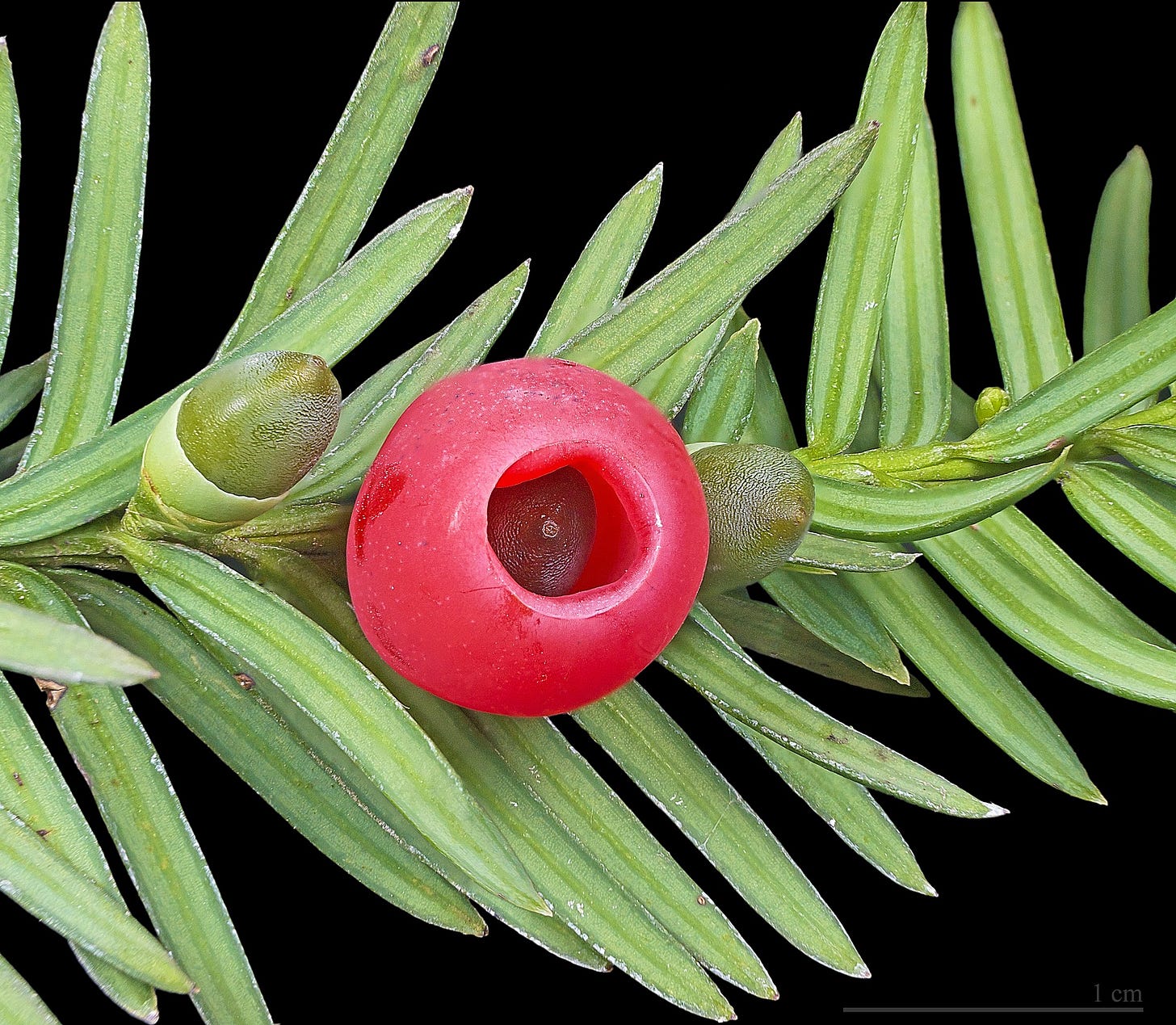
Cherry ballarts (Exocarpos species) are another potential look-alike found only on the Australian continent, especially because ballarts, like plum pines, exhibit a single seed at the tip of their swollen-stem “fruit.” Ballarts will typically have whitish, light pink or red fruit, a red, maroon or black seed at the tip, and the trees typically have either rather broad or no apparent leaves. Fortunately, like its distant plum pine relatives, cherry ballarts are completely edible and may be enjoyed with gusto. I am yet to encounter a ballart in my exploratory travels, but they are far more common than Podocarpus and extend into many of the drier, arid and frost-prone interior regions, including Uluru, despised by the coast-loving plum pines.
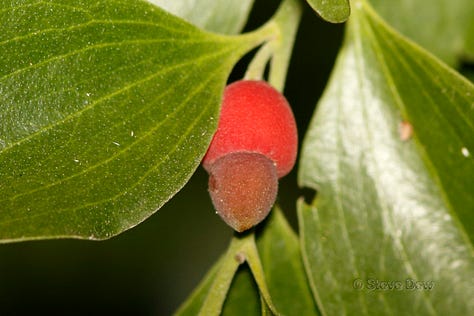
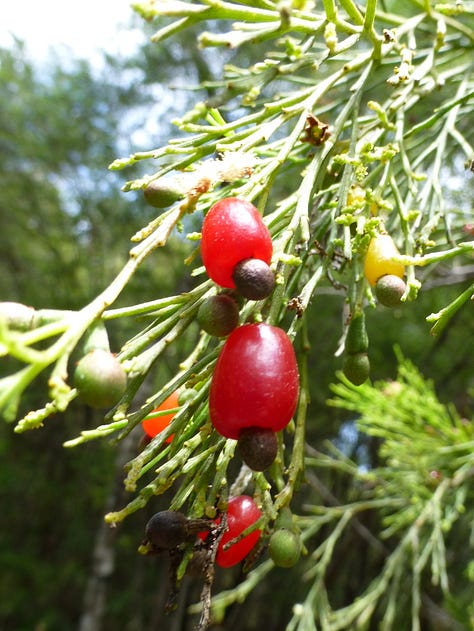

Caution!
All parts of the plum pine are poisonous, including the edible fruit, but moreso the leaves, bark and pollen. Keep your ingestion of the fruit moderate and avoid the resinous cores; I have personally consumed 5-6 plum pine fruits per day, cores removed, for an entire month to no ill effect.
References/Further Reading
Atlas of Living Australia, “P. dispermus” [LINK]; “P. drouynianus” [LINK]; “P. elatus” [LINK]; “P. grayae” [LINK]; “P. lawrencei” [LINK]; “P. smithii” [LINK]; “P. spinulosus” [LINK].
Abdillahi, Finnie and Van Staden (2008), “Antimicrobial activity of South African Podocarpus species.” Journal of Ethnopharmacology 119 (1): 191-194. [LINK]
Abdillahi, Finnie and Van Staden (2011), “Anti-inflammatory, antioxidant, anti-tyrosinase and phenolic contents of four Podocarpus species used in traditional medicine in South Africa.” Journal of Ethnopharmacology 136 (3): 496-503 [LINK]
Beentje (1994), Kenya trees, shrubs, and lianas. Nairobi: National Museums of Kenya. [LINK]
Chopra, Nayar & Chopra (1986). Glossary of Indian Medicinal Plants. New Delhi: Council of Scientific and Industrial Research.
Deng et al. (2023), “A comprehensive review on the medicinal usage of Podocarpus species: Phytochemistry and pharmacology.” Journal of Ethnopharmacology 310: 116401 [LINK]
Duke & Ayensu (1985), Medicinal Plants of China. Algonac: Reference Publications Inc.
Easterfield (1910), “Studies on the Chemistry of the New Zealand Flor. Part IV— The Chemistry of the Podocarpi.” Transactions and Proceedings of the New Zealand Institute 43: 53-55. [LINK]
Easterfield & McDowell (1915), “The Chemistry of Podocarpus totara and Podocarpus spicatus.” Transactions of the New Zealand Institute. 48: 518–520. [LINK]
Hansen and Horsfall (2019), Noongar Bush Tucker, pp. 376-377.
Hutchings (1996), Zulu Medicinal Plants— An Inventory. Pinetown: University of Natal Press. [LINK]
Jordan (2011), Podocarpus macrophyllus. [LINK]
Roy et al. (1987), “Biflavones from the genus Podocarpus.” Phytochemistry 26 (7): 1985-1987. [LINK]
Low (1989), Bush Tucker, pp. 44-45 (P. lawrencei); 62 (P. elatus).
Low (1991), Wild Food, p.88 (P. elatus); 201 [nutritional information].
Maiden (1889), Useful Native Plants, p.53 (P. spinulosus, fruit); 589-590 (P. elatus, wood).
Mani et al. (2022), “Bioassay Guided Fractionation Protocol for Determining Novel Active Compounds in Selected Australian Flora.” Plants 11 (21): 2286 [LINK]
Masika & Afolayan (2003), “An Ethnobotanical Study of Plants Used for the Treatment of Livestock Diseases in the Eastern Cape Province, South Africa.” Pharmaceutical Biology 41 (1): 16-24. [LINK]
Miura, Kihara and Kawano (1969), “Studies on Bisflavones in the Leaves of Podocarpus macrophylla and P. nagi.” Chemical and Pharmaceutical Bulletin 17 (1): 150-154. [LINK]
Netzel et al. (2006), “Sources of Antioxidant Activity in Australian Native Fruits. Identification and Quantification of Anthocyanins.” Journal of Agricultrual and Food Chemistry 54 (26): 9820–9826. [LINK]
Ogren, Thomas L (2000). Allergy-Free Gardening: The Revolutionary Guide to Healthy Landscaping. Berkeley: Ten Speed Press. [LINK]
Paitu Ponderings (Feb., 2024), “Totara berries edible delight!” [LINK]
Riley (1994), Maori Healing and Herbal: New Zealand Ethnobobtanical Sourcebook. Wellington: Vikings Sevenseas.
Russell, Fenemore and Singh (1973), “Insect-control chemicals from plants. Nagilactone C, a toxic substance from the leaves of Podocarpus nivalis and P. hallii.” Australian Journal of Biological Sciences 25 (5): 1025-1030. [LINK]
Short & Stromberg (1937). “116. Totarol. Part I.” Journal of the Chemical Society (Resumed), pp. 516-520. [LINK]
Short & Wang (1951). “662. Totarol. Part II.” Journal of the Chemical Society (Resumed), pp. 2979-2987. [LINK]
South Coast Distillery (2024 Catalogue), “Illawarra Plum Fruit Gin.” [LINK]
Symonds, Konczak and Fenech (2013), “The Australian fruit Illawarra plum (Podocarpus elatus Endl., Podocarpaceae) inhibits telomerase, increases histone deacetylase activity and decreases proliferation of colon cancer cells.” British Journal of Nutrition 109 (12): 2117-2125 [LINK]
Tan et al. (2011a), “Native Australian Fruit Polyphenols Inhibit Cell Viability and Induce Apoptosis in Human Cancer Cell Lines.” Nutrition and Cancer 63 (3): 444-555 [LINK]
Tan et al. (2011b), “Potential Antioxidant, Antiinflammatory, and Proapoptotic Anticancer Activities of Kakadu Plum and Illawarra Plum Polyphenolic Fractions.” Nutrition and Cancer 63 (7): 1074-1084 [LINK]





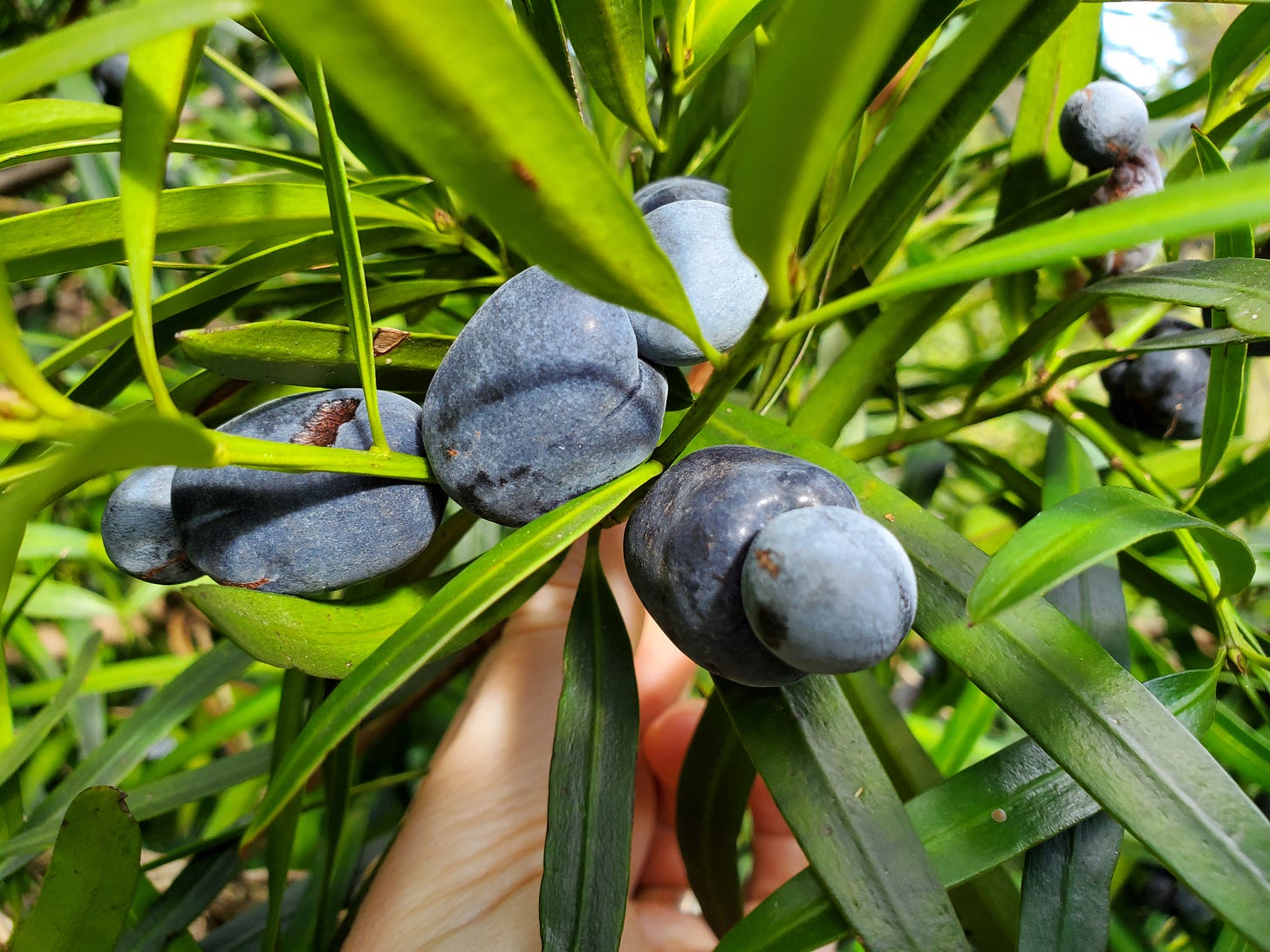

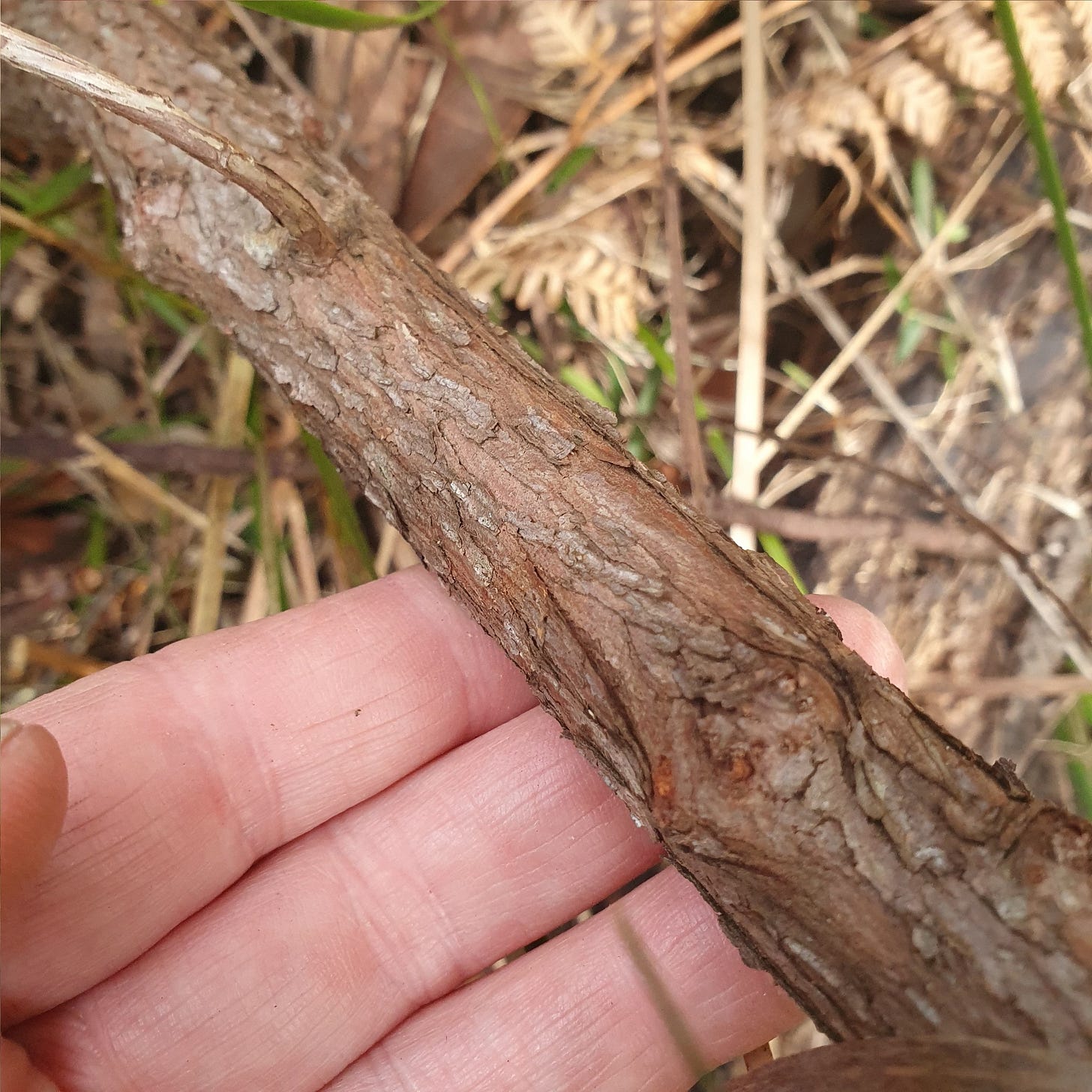
Fantastic article JP! So detailed. Well done.
The colour is a bit how you going (I'm colour blind) but love your content mate.